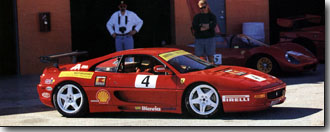

The third and last of Ferrari's fabuous F50 GT1 contenders recently underwent pre-delivery testing at Willow Springs. FORZA's Peter Brock was there with his cameras and tape recorder.
 During each year of this frenetic present era, the top designers of endurance racers have pushed the envelope so far that it became necessary to design completely new cars for the following season, a formula literally destined for self destruction. History has proven that no racing series can survive without rules stability. Ferrari seemed poised to enter the fray in '96 with their incredible F50 coupes, but two factors dictated otherwise. First, budgetary restraints at Maranello, combined with the factory's all-out emphasis on Formula One, killed the program, with only three prototypes ever completed.
During each year of this frenetic present era, the top designers of endurance racers have pushed the envelope so far that it became necessary to design completely new cars for the following season, a formula literally destined for self destruction. History has proven that no racing series can survive without rules stability. Ferrari seemed poised to enter the fray in '96 with their incredible F50 coupes, but two factors dictated otherwise. First, budgetary restraints at Maranello, combined with the factory's all-out emphasis on Formula One, killed the program, with only three prototypes ever completed.  Spiro, too, was suitably impressed. "I know how fast my Cobra is, but this F50 really is in a class by itself. It's fast and totally composed- amazing." Spiro and Theys spent several hours at speed together. By the end of the afternoon, Spiro's lap times in his new cars were noticeably faster than the morning's first forays into the unknown. "This is all very new to me," he said. "I realize I'm so far in over my head that its going to take a long time to absorb all I've learned. But having Didier here with the cars to teach me was a truly wonderful experience. It's something I've wanted to do all my life, and now that the day is coming to an end, I'm just beginning to understand how much I really have to learn. These Ferraris are the most amazing cars I've ever driven - I'd never have believed it had it not been for today."
Spiro, too, was suitably impressed. "I know how fast my Cobra is, but this F50 really is in a class by itself. It's fast and totally composed- amazing." Spiro and Theys spent several hours at speed together. By the end of the afternoon, Spiro's lap times in his new cars were noticeably faster than the morning's first forays into the unknown. "This is all very new to me," he said. "I realize I'm so far in over my head that its going to take a long time to absorb all I've learned. But having Didier here with the cars to teach me was a truly wonderful experience. It's something I've wanted to do all my life, and now that the day is coming to an end, I'm just beginning to understand how much I really have to learn. These Ferraris are the most amazing cars I've ever driven - I'd never have believed it had it not been for today." Want more information? Search the web!
Search The Auto Channel!